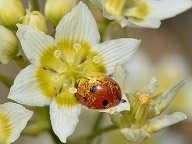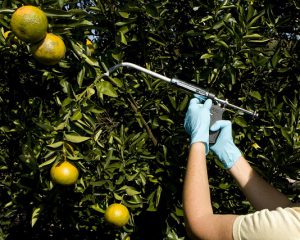By Olivia Zugay and Violet Krochmalny
Pollinator Points – Diversity
When the act of pollination comes up, many immediately think of bees and butterflies as the primary movers of pollen. However, they are only two of the many species of insects and animals that work to transport pollen from your garden to your neighbors’ and around the globe. The following are some of the pollinator points on diversity to help you with your Florida Friendly gardens.
It is important to promote and maintain diversity in your garden as a way to increase health and the number of pollinators within your area. Diversity can be achieved in many ways, such as:
- Providing shelter for multiple species, ex) bat and bird houses
- Having a water source available
- Having a diverse ecosystem with a variety of plant types, heights and textures
Other than bees and butterflies, it is also beneficial to help other individuals to flourish. Other pollinators can include, but are not limited to: bats, birds, beetles & other insects, lizards and humans. Pollination can also occur through the movement of wind and water, and some plant species don’t even require the help of pollinators, but are able to self-pollinate.


For more pollinator information:
http://solutionsforyourlife.ufl.edu/hot_topics/lawn_and_garden/pollination.shtml
http://www.tcbeekeepers.org/
Pollinator Points – Pesticide Safety
Many Homeowners are interested in having a more pollinator friendly landscape. As well as strategies to encourage and attract diversity, there are also ways to minimize threats to pollinator health. Along with loss of habitat, the most significant risk of harm is improper use of pesticides. By utilizing an integrated approach to pest management (IPM), homeowners and landowners can greatly reduce the frequency, amount and toxicity of applied pesticides. IPM principles include using the least toxic method of pest control, choosing pest-resistant plants, and encouraging the natural enemies of pests. When the use of chemicals are necessary, reduce the risk of exposure of harmful pesticides to people, animals, and the environment by the following methods of pesticide etiquette:
IPM principles include using the least toxic method of pest control, choosing pest-resistant plants, and encouraging the natural enemies of pests. When the use of chemicals are necessary, reduce the risk of exposure of harmful pesticides to people, animals, and the environment by the following methods of pesticide etiquette:
- Choose natural soap & oil products or selective chemicals such as insect growth regulators
- Spot treat instead of broadcast
- Avoid systemics, which may result in contaminated pollen
- Avoid mixed products or broad spectrum insecticides
- Avoid microencapsulated, dusts and wettable powder formulations, which can stick to pollinators and be brought back to their nests, instead choose liquid or granulated formulations
- Apply late in the day when most pollinators are inactive
- Avoid windy days, which cause off target drift
Always follow the instructions on the product label, the label is the law!

More information on IPM can be found on this University of Florida’s website: http://livinggreen.ifas.ufl.edu/landscaping/
More information on reducing risk of pesticide toxicity can be found at: http://edis.ifas.ufl.edu/pdffiles/IN/IN102700.pdf
 0
0
